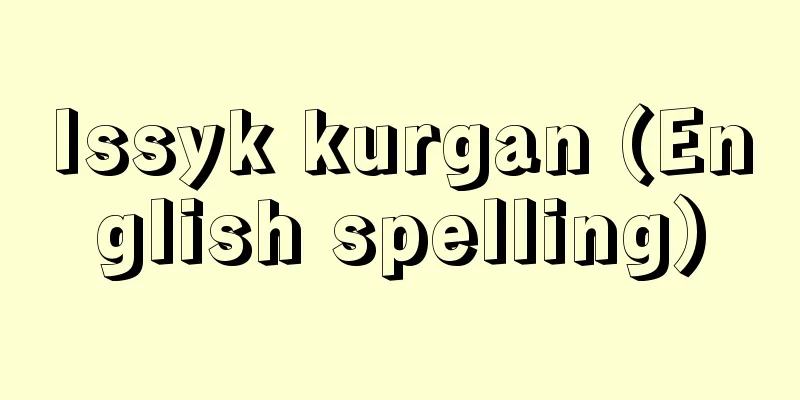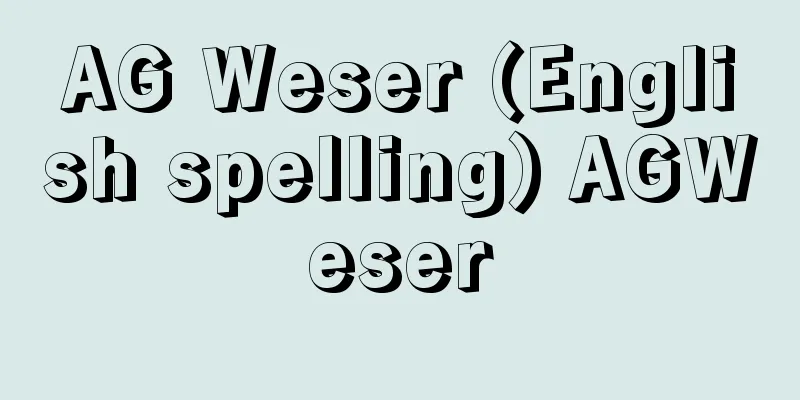Paint and varnish

|
A general term for a liquid substance that is spread over the surface of an object to create a thin layer, which is then solidified and used to protect or color the surface of the object. [Hiroshi Kakiuchi] Purpose of paint useObjects are subject to some degree of erosion due to external influences, large or small. Also, the material alone often has little superficial commercial value. Therefore, in order to protect them from external influences, they are painted with paint for the following purposes: (1) Protection of objects, anti-corrosion, oil and chemical resistance, moisture proofing, etc. (2) Giving a glossy finish, beautifying, smoothing, marking, etc. (3) Prevention of adhesion of living organisms, sterilization, conductivity adjustment, reflection, etc. [Hiroshi Kakiuchi] Composition and classificationThe main components of paint are the vehicle (binder) that forms the paint film, and the pigment. The vehicle is the equivalent of a transparent paint, and is the component that disperses the pigment and gives the paint fluidity, while the pigment is the component that gives the paint film its color. [Hiroshi Kakiuchi] historyThe history of paint began with paintings that used vehicles and pigments. This dates back to the Stone Age 20,000 years ago, when cave paintings could be seen in Altamira, Spain. At that time, clay such as ochre was used as coloring matter, or pigment, and water, gum arabic, eggs, gelatin, etc. were used as vehicles. Similar paintings remain from the Greek and Roman periods. Varnish appeared in Egypt around 1000 BC. Soft natural resins such as frankincense and sandarac were thoroughly mixed with vegetable oil, and the mixture was applied with fingers or knives. Mummy coffins from those times that were painted in this way are still preserved intact today. The production of drying oil varnish began as a home industry around 1670, and varnish factories were established in France and Germany in the 1800s. In the second half of the 19th century, as economic activity became more active, the demand for paint increased, leading to the appearance of rosin-modified glycerin ester varnish in 1890 and synthetic resin paints such as oil-modified alkyd resin in 1927. Emulsion paint was developed in 1940, and after World War II, with the development of plastics (synthetic resins), many synthetic resin paints using them as a raw material appeared. [Hiroshi Kakiuchi] JapanJapan also has a long history of paints, and in the Jomon and Yayoi periods, lacquer, colored clay, and paints made by kneading metal oxides with oil, starch, and glue were used for painting and coloring. In addition to the well-known lacquer, Japanese paints mainly consisted of persimmon tannins and paulownia oil, and were used to waterproof and preserve everyday items and various types of wood for the common people. After a long period of isolationism, oil paints were imported from Europe for the first time. Domestic production of paints was also required for military reasons, and in 1881 (Meiji 14) Komyosha (later Nippon Paint Co., Ltd.) was established in Tokyo, where it began manufacturing zinc oxide, boiled oil, and thick paint. The navy sought to protect and develop domestic paints for the sake of national defense, and as the navy expanded, research and development was carried out on ship bottom paints. When World War I began in 1914 (Taisho 3), the supply of paints from Europe and the United States to Japan was cut off. This led to a dramatic increase in domestic paint production, which not only met domestic demand, but also monopolized the supply to the Asian market. The number of paint factories also grew from 28 at the end of the Meiji period to 101 at the end of the Taisho period. After World War II, new paints were developed one after another, including urea resin, melamine resin paints, and emulsion paints, followed by epoxy resin paints, ushering in the era of synthetic resin paints. [Hiroshi Kakiuchi] Paint raw materialsThere are many types of paint raw materials, which can be broadly divided into the main and secondary components that make up the paint film, pigments, and solvents. Drying or semi-drying oils and fats are still the main raw materials for the main components that make up the paint film, but since around 1980 they have been replaced by various synthetic resin paints. The use of natural resins has also decreased, but derivatives from natural rubber and cellulose are still widely used. In contrast, synthetic resins are of consistent quality and have a stable supply, making them the mainstream of paints today. They also have the distinctive feature of being able to be modified to match the properties of the paint film required. Secondary components are the driers and plasticizers mentioned above. Pigments are generally colored powders that are insoluble in water or solvents, and are distinct from dyes, which are soluble in solvents. The effects of adding pigments to paints include coloring, concealment, viscosity, coating reinforcement, and corrosion prevention. Even in the paint state, the pigments are sufficiently dispersed in the vehicle, and remain dispersed even after the paint film dries. Solvents are generally added to keep paint fluid. Most solvents are organic, but their use has been greatly restricted since the second half of the 20th century due to concerns about air pollution caused by their evaporation. Water-soluble paints are diluted with water, but in this case water is not considered a solvent. It is preferable to use solvents that have little impact on the environment and are not flammable. [Hiroshi Kakiuchi] Paint manufacturing methodPaints are called by various names depending on the classification method, but below we will write about oil-based paints. Oil-based paints are paints that use vehicles mainly made from natural oils and fats, and include lacquer, cashew-based paints, oil paints, and oil-based enamels. [Hiroshi Kakiuchi] Lacquer, cashew-based paintCashew-based paints are similar to lacquer. Cashew kernel oil extracted from the shells of Indian cashews contains cardol and anacardic acid, which are similar to urushiol. The vehicle that is heated and reacted with oil-soluble phenolic resin is used as a substitute for lacquer. [Hiroshi Kakiuchi] Oil PaintThis paint uses boiled oil as a vehicle. Boiled oil is made by adding a drying agent to drying oils such as soybean oil, linseed oil, tung oil, and fish oil, and then oxidizing and polymerizing the oil at temperatures below 120°C while blowing in air until it reaches an appropriate viscosity, and then adding a drying agent to this to create the vehicle. It is also simply called paint or paint. Depending on the ratio of pigment and boiled oil, there are thick paints (85-90% pigment) and mixed paints (60-65% pigment). Oil paint dries slowly and has poor hardness, water resistance, and alkali resistance. [Hiroshi Kakiuchi] Oil-based enamelOil-based varnish is a varnish whose main ingredient is a polymer of natural or synthetic resin and drying oil. Oil-based enamel, simply called enamel or enamel paint, is made by dispersing pigments in oil-based varnish. It is inexpensive and produces a coating with excellent gloss when used for room temperature drying or baking. While oil paint uses drying oil or boiled oil as a vehicle, enamel paint uses a low-viscosity oil varnish made by heating and polymerizing resin (natural resin, rosin-modified maleic acid resin, phenolic resin, and other synthetic resins) and drying oil, to which a solvent and drying agent are added, as the vehicle. Varnish is generally a transparent liquid that, when applied to the surface of an object, dries by the evaporation of the solvent or the oxidation of the contained components, forming a smooth, glossy coating. [Hiroshi Kakiuchi] Synthetic resin paintThey have been rapidly developed since around 1950, and their uses are expanding due to their excellent properties. The main uses are described below. Many synthetic resins are used as vehicles. (1) Alkyd resin paints are polyesters obtained from phthalic anhydride and glycerin or pentaerythritol modified with drying oil or its fatty acid. Fatty acids, phthalic anhydride, and polyhydric alcohols are mixed and polycondensed in an inert gas at 220-250°C to create polyester. The principle is the same when using fats and oils. Such resins are called alkyd resins, and their properties vary depending on the number of double bonds in the drying oil or its fatty acid used for modification, and the proportion of fatty acid moieties in the alkyd resin (called the oil length). The average molecular weight of alkyd resin for paint is 2000-3000, but after application, the double bonds of the fatty acids undergo an air oxidative crosslinking reaction, forming a coating film with a high molecular weight and strong network structure. Metal salts such as cobalt naphthenate are used as catalysts for this reaction. These are known as drying agents. Alkyd resins have a high adhesion due to the large number of hydroxyl groups and organic acid groups in their structure, but because they are mainly composed of ester bonds, they have low water resistance and alkali resistance. (2) Amino alkyd resin paints are made by reacting melamine or urea with formaldehyde in an alkaline environment, then modifying the resulting mixture with butanol or other substances and mixing it with alkyd resin to form a vehicle, and can be baked at low temperatures. They are colorless and transparent, with good color retention, weather resistance, and chemical resistance, and are also robust and flame-retardant. (3) Acrylic resin paint: A typical synthetic resin paint, it uses a copolymer of acrylic acid and methacrylic acid esters as a vehicle, with methyl esters forming a hard coating film and butyl or 2-ethylhexyl esters forming a soft coating. It has excellent transparency, colorfastness, gloss, and weather resistance, and is widely used as a topcoat for buildings, home appliances, automobiles, etc. (4) Phenolic resin paints These are classified as oil-based paints because the vehicle is a reaction product of oil-soluble phenolic resin and oil. The phenolic resin used is called novolac resin, which is made by reacting phenol with an aqueous formaldehyde solution under acidic conditions. They are often used as undercoats and chemical-resistant paints. (5) Epoxy resin paint Epoxy resin is a highly reactive resin with epoxide and hydroxyl groups, which act as the center of cross-linking reactions to create a three-dimensional polymer network coating. It has excellent adhesion, impact resistance, and gloss, and is widely used in the automotive industry as an undercoat. (6) Unsaturated polyester resin paints are polyesters made from unsaturated dibasic acids (those with two organic acid groups in the molecule) such as maleic anhydride and ethylene glycol or propylene glycol, and the paint is dissolved in styrene or other unsaturated monomers before use. They are widely used as finishing paints for wood products. (7) Polyurethane resin paints are polyester-polyisocyanate based paints that form a coating in the form of urethane by reacting polyol with diisocyanate. They are widely used as floor paints. [Hiroshi Kakiuchi] Painting MethodPrior to painting, the surface to be painted is pretreated. Any dirt adhering to the surface is removed with sandpaper or an abrasive cloth, and then the surface is cleaned with trichloroethylene (trichlene) or acetone to improve the adhesion of the paint film. Generally, surface pretreatment is not necessary to a large extent. There are many different painting methods, depending on the type of paint and the object being painted. These include brush painting, roller painting, spray painting, electrostatic spray painting, electrostatic powder painting, and metal electrodeposition painting, and different methods are used depending on the situation. Painting is rarely completed with just one coat of one type of paint; in most cases, two or more coats are applied. Before applying additional coats, the paint film is often polished to improve its flatness. Since the 1980s, a method that simplifies pre-treatment by using epoxy resin-based cationic electrodeposition paint for the electrodeposition coating of the undercoat has been adopted in various countries. An acrylic-based paint is often used for the top coat. [Hiroshi Kakiuchi] Paint IndustryJapan's paint industry, which began in 1881 (Meiji 14), rapidly increased its production volume along with the subsequent development of industry in Japan, but the number of manufacturers also increased significantly, leading to fierce competition. In the early days, paints were made of lacquer, which was made by dissolving nitrocellulose in a solvent, and was considered to be fast-drying, had beautiful colors, a glossy finish, and had a hard film. However, from around 1929 (Showa 4), synthetic resin-based paints such as oil-soluble phenolic resins began to be produced. These paints have extremely high film hardness, excellent resistance to acids and alkalis, and are fast-drying varnishes, and were used as a substitute for lacquer. In 1931, alkyd resin-based paints made from phthalic anhydride, vegetable oil fatty acids, and glycerin appeared, which were fast-drying and durable, and became the focus of paint production before World War II. After the war, water-based emulsion paints, urea-based water-soluble paints, and melamine-based baking paints began to be put to practical use. With the subsequent development of petrochemistry, new solvents such as isopropyl alcohol, methyl isobutyl ketone, and cellosolve were imported and then domestically produced. Using these, paints with a high solid content that could form a thick film at once were realized. The raw materials for synthetic resin paints themselves also became petrochemical products, and cheap, stable quality paints began to be supplied. Furthermore, in the 1950s, epoxy resin-based paints were developed that undergo a chemical reaction after application. Unlike conventional oil-based paints, which dry and harden in the air, these paints have good adhesion and durability. These reactive curing paints include unsaturated polyester and urethane paints. [Hiroshi Kakiuchi] The future of paintIn the future, it is expected that powder coatings, UV-curing, electron beam-curing, or water-solvent coatings will become more popular in order to reduce the use of organic solvents, which account for more than 40% of paint and are one of the causes of photochemical smog. In addition, the development of so-called "functional coatings" that are not limited to the protection and coloring of the surface of objects as in conventional coatings but have special functions such as (3) in [Purpose of using coatings] is expected, and many such coatings, such as radio wave absorbing coatings and conductive coatings, have already been developed and are in use. Since the 1990s, fluororesin coatings with good weather resistance have been adopted because the repainting of high-rise buildings and offshore bridges is becoming longer. [Hiroshi Kakiuchi] "The Chemistry of Paint Resins" by Kakiuchi Hiroshi (1972, Shokodo)" ▽ "Practical Knowledge of Paints" 2nd Edition edited by Kozu Haruo (1981, Toyo Keizai Shinposha)" ▽ "New Edition Paints and Coatings" edited by the Chemical Society of Japan, written by Tamehiro Shigeo and Ueki Noriharu (1984, Dainippon Tosho)" ▽ "High-Performance Paints Editorial Committee edited, "New Material Utilization Series: High-Performance Paints" (1988, Kogyo Chosakai)" ▽ "Fluoroplastics Handbook" edited by Satokawa Takaomi (1990, Nikkan Kogyo Shimbun)" ▽ "Amazing New Paints - From Invisible Bombers to Solar Cells" by Tobayama Mitsuru (1990, Kodansha)" ▽ "Paint Terminology Dictionary" edited by the Color Materials Association (1993, Gihodo Publishing)" ▽ "Paints and Coatings" by Kodama Masao et al. (1994, Power Co.)" ▽ "Painting Handbook" edited by Ishizuka Suetoyo et al. (1996, Asakura Publishing)" ▽ "New Developments in Functional Coatings" edited and published by Toray Research Center (1998)" ▽ "Latest Technology and Market of Water-Based Coatings supervised by Kiryu Haruo (1998, CMC)" ▽ "Development and Applications of Powder Coatings" by Takeda Susumu (1999, CMC)" ▽ "Easy-to-Understand Paints and Coating Technology" by Hasegawa Kenzo (2001, Nippon Riko Publishing)" ▽ "Development of Special Functional Coatings" edited and published by CMC (2001) ▽ "Paint Yearbook" edited and published by Paint Hochi Shimbun, 2003 edition (2002)" ▽ "How to Select and Use Paints" revised 3rd edition edited by Ueki Kenji (2002, Japanese Standards Association)" ▽ "JIS Handbook of Paints" edited and published by the Japanese Standards Association, 2003 edition (2003)" ▽ "The Fundamentals and Properties of High-Performance Paints" edited by Haruo Kiryu et al. (2003, CMC) "The Story of Urushi" by Gonroku Matsuda (Iwanami Bunko) [Reference items] | | | | | | | | | | | | | | | | | | | | | | | | | | | | | | | |©Shogakukan "> Main components of urushiol and cashew kernel oil ©Shogakukan "> Example of painting method (car painting process) Source: Shogakukan Encyclopedia Nipponica About Encyclopedia Nipponica Information | Legend |
|
流動体物質を物体の表面に塗り広げて薄い層をつくり、のちに固化して物体の表面の保護、着色などのために用いられるものの総称。 [垣内 弘] 塗料使用の目的物体は大なり小なり外的な影響によって、なんらかの侵食作用を受ける。また、素材のみでは表面的な商品価値が低い場合が多い。そこで外界からの影響を受けないように保護し、次のような目的のために塗料で塗装する。(1)物体の保護、防食、耐油・耐薬品、防湿など。(2)光沢の付与、美化、平滑化、標識など。(3)生物の付着防止、殺菌、伝導性調節、反射など。 [垣内 弘] 組成と分類塗料の主成分は、塗膜形成成分のビヒクルvehicle(展色料)と、顔料成分からできている。ビヒクルというのは透明塗料に相当するもので、顔料などを分散させて塗料に流動性を与える成分であり、顔料は塗膜に色彩を付与する成分である。 [垣内 弘] 歴史塗料の歴史は、ビヒクルと顔料を用いた絵画に始まる。それは2万年前の石器時代にまでさかのぼり、スペインのアルタミラなどの洞窟(どうくつ)画がみられる。当時の着色料すなわち顔料は、黄土のような粘土、ビヒクルには水、アラビアゴム、卵やゼラチンなどが用いられた。ギリシアやローマ時代にも同じような絵画が残っている。紀元前1000年ごろには、エジプトにワニスが現れた。乳香やサンダラックのような軟質の天然樹脂を植物油とよく練り合わせ、これを指やナイフを使って塗り付けた。この塗装を施した当時のミイラの棺は、現在でも損なわれることなく保存されている。 乾性油ワニスの製造は、1670年ごろから家内工業的に始まり、1800年代にフランス、ドイツにワニス工場が設立された。19世紀後半に、経済活動が活発になるとともに塗料の需要が増大して、1890年にはロジン変性グリセリンエステルのワニスが、1927年に油変性アルキド樹脂のような合成樹脂塗料が登場してきた。1940年にエマルジョン塗料が開発され、第二次世界大戦後、プラスチック(合成樹脂)が発展するのに伴い、これを原料とする合成樹脂塗料が多く登場した。 [垣内 弘] 日本日本の塗料の歴史も古く、縄文時代、弥生(やよい)時代に、漆や着色粘土、金属酸化物を油やデンプン、にかわ(膠)などと練り上げてつくった絵の具や漆が塗装や彩色に用いられた。日本の塗料は、代表的な漆のほかに柿渋(かきしぶ)、桐油(きりゆ)などを主とし、庶民の日用品、さまざまな木材などに防水、防腐の目的で施された。 長い間の鎖国政策ののち、初めてヨーロッパから油塗料のペンキが輸入された。軍事的な面からも塗料の国産化が要望されて、1881年(明治14)東京に光明(こうみょう)社(後の日本ペイント株式会社)が設立され、亜鉛華、ボイル油、堅練りペイントなどの製造に着手した。海軍が国防上の必要から国産塗料の保護育成を図り、海軍の拡張につれて船底塗料関係の研究・開発が行われた。1914年(大正3)に第一次世界大戦が始まって、欧米から日本への塗料の供給が途絶えた。これを契機として国産塗料の製造が飛躍的に増大し、国内需要にこたえたばかりでなく、アジア市場への供給も独占した。塗料工場も明治末の28工場から、大正末には101工場へと発展している。 第二次世界大戦後は、ユリア樹脂(尿素樹脂)やメラミン樹脂塗料、エマルジョン塗料の生産、続いてエポキシ樹脂塗料など、次々と新しい塗料が開発され、合成樹脂塗料時代に入っている。 [垣内 弘] 塗料の原料塗料の原料は多種類にわたり、塗膜構成主要素と副要素、顔料と溶剤とに大別される。塗膜構成主要素として乾性または半乾性油脂は現在でもおもな原料ではあるが、1980年ごろから各種合成樹脂塗料に置き換わってきた。天然樹脂の使用も減少したが、天然ゴムや繊維素からの誘導体はいまでもよく使われている。これに対して合成樹脂は品質が一定で、かつ供給も安定化しているので今日の塗料の主流となっている。とくに要求される塗膜の性質にマッチするような変性が可能という特色ももっている。副要素的なものは先に述べた乾燥剤や可塑剤的なものである。 顔料は一般に水や溶剤に不溶の有色の粉末で、溶剤に可溶の染料と区別される。塗料に対する顔料添加の効果は、着色、隠蔽(いんぺい)、粘性の付与、塗膜の補強、防食などである。塗料状態でも顔料はビヒクル中に十分に分散しており、塗膜として乾燥したあとでも分散した状態を保っている。 溶剤は、一般に塗料を流動状態に保つために加える。有機系の溶剤が多いが、20世紀後半以降、その蒸発による大気汚染を警戒して使用が大幅に制限されるようになった。水溶性塗料は水で希釈するが、この場合は水を溶剤とはいわない。環境に与える影響が小さく、引火性の少ないものを使うのが望ましい。 [垣内 弘] 塗料の製造法塗料は分類法によりさまざまな名称でよばれるが、以下、油性塗料に属するものについて記す。 油性塗料はおもに天然の油脂などから製造されるビヒクルを用いる塗料であり、漆、カシュー系塗料、油ペイント(油性ペイント)、油性エナメルなどがある。 [垣内 弘] 漆、カシュー系塗料漆に似たものにカシュー系塗料がある。インド産カシュー実の殻から抽出したカシュー核油はウルシオールによく似た成分、カルドールやアナカルド酸を含有している。油溶性フェノール樹脂といっしょに加熱し反応させたビヒクルは、漆の代用として使われている。 [垣内 弘] 油ペイントボイル油をビヒクルとした塗料で、ボイル油は大豆油、あまに油、桐油、魚油などの乾性油に乾燥剤を加えて、120℃以下の温度で空気を吹き込みながら適当な粘度になるまで酸化重合させたもので、これにさらに乾燥剤を加えてビヒクルとする。単にペイントあるいはペンキともいう。顔料とボイル油の配合比によって堅練りペイント(顔料85~90%)と調合ペイント(顔料60~65%)がある。油ペイントは乾きが遅く、堅さ、耐水性、耐アルカリ性に乏しい。 [垣内 弘] 油性エナメル油性ワニスは天然樹脂あるいは合成樹脂と乾性油の重合体を主原料とするワニスをいう。油性ワニスに顔料を分散させたものが油性エナメルで、単にエナメルあるいはエナメルペイントともいう。常温乾燥用や焼付け塗料として、安価で優れた光沢の塗膜を与える。油ペイントはビヒクルとして乾性油またはボイル油を使うのに対して、エナメルペイントは樹脂(天然樹脂やロジン変性マレイン酸樹脂、フェノール樹脂などの合成樹脂)と乾性油を加熱重合し、それに溶剤、乾燥剤を添加した粘度の低い油性ワニスをビヒクルとしている。 ワニスは一般には透明な液体で、物体の表面に塗布すると溶剤の揮発または含有成分の酸化によって乾燥し、滑らかな光沢のある塗膜を形成する塗料をいう。 [垣内 弘] 合成樹脂塗料1950年ごろから急速に開発され、その優れた性質のため用途がますます拡大している。そのおもなものについて記述する。多くの合成樹脂がビヒクルとして使用されている。 (1)アルキド樹脂塗料 無水フタル酸とグリセリンまたはペンタエリスリットとから得られたポリエステルを乾性油またはその脂肪酸で変性したものである。脂肪酸と無水フタル酸と多価アルコールの三者を混合して不活性ガス中で220~250℃でポリ縮合させてポリエステルをつくる。油脂を使うときも原理は同じである。このような樹脂をアルキド樹脂といい、変性に用いた乾性油またはその脂肪酸の二重結合の数や、アルキド樹脂中の脂肪酸部分の割合(これを油長という)によって変化する。 塗料用アルキド樹脂の平均分子量は2000~3000であるが、塗装後脂肪酸の二重結合が空気酸化架橋反応をおこし、高分子量のじょうぶな網目構造をもった塗膜を形成する。この反応の触媒としてナフテン酸コバルトなどの金属塩が用いられる。これがいわゆる乾燥剤である。アルキド樹脂は構造中にヒドロキシ基や有機酸基を多くもっているので密着性に富んではいるが、エステル結合が主体なので耐水性、耐アルカリ性は低い。 (2)アミノアルキド樹脂塗料 メラミンあるいは尿素とホルムアルデヒドとをアルカリ性で反応させたのち、ブタノールなどで変性したものをアルキド樹脂と混合してビヒクルとしたもので、低温焼付けが可能である。無色透明、良好な保色性、耐候性、耐薬品性をもち、かつ堅牢(けんろう)で難燃性でもある。 (3)アクリル樹脂塗料 合成樹脂塗料の代表的なもので、アクリル酸、メタクリル酸のエステル類の共重合体をビヒクルとしたもので、メチルエステルは硬質の塗膜となり、ブチルあるいは2-エチルヘキシルエステルでは軟質となる。透明性、無変色性、光沢、耐候性などに優れ、建造物、家電製品、自動車などの上塗り塗料として広く用いられている。 (4)フェノール樹脂塗料 油溶性フェノール樹脂と油との反応物をビヒクルとするので油性塗料として分類されている。用いるフェノール樹脂はノボラック樹脂といわれるもので、フェノールとホルムアルデヒド水溶液とを酸性で反応してつくられる。下地塗り塗料や耐薬品塗料として多く用いられている。 (5)エポキシ樹脂塗料 エポキシ樹脂は反応性に富んだエポキシドとヒドロキシ基をもった樹脂であり、これが架橋反応の中心となって三次元の網目高分子の塗膜をつくりあげる。密着性と耐衝撃性や光沢が優れ、下塗り用として自動車工業に広く用いられている。 (6)不飽和ポリエステル樹脂塗料 無水マレイン酸などの不飽和二塩基性酸(有機酸基を二つ分子内にもっているもの)とエチレングリコールまたはプロピレングリコールとのポリエステル型で、塗料はスチレンやその他の不飽和モノマーに溶解して用いる。木製品仕上げ塗料として多く使用されている。 (7)ポリウレタン樹脂塗料 ポリエステル‐ポリイソシアネート系のもので、ポリオールとジイソシアナートとを反応させたウレタンの形で塗膜を形成している。床面塗料として重用されている。 [垣内 弘] 塗装方法塗装に先だって、塗布面の前処理が行われる。付着している汚れは、サンドペーパーや研摩布で研摩し、あとトリクロロエチレン(トリクレン)やアセトンなどで洗浄して塗膜の密着性能をあげるようにする。一般にはそれほど表面の前処理は必要としない。 塗装方法は塗料の種類や塗装される物体によって非常に多くの方法がある。刷毛(はけ)塗り、ローラー塗り、吹付け塗装、静電スプレー塗装、静電粉体塗装、金属電着塗装などがあり、場合によって使い分けられている。塗装は1種類の塗料を1回塗装したのみで終わる場合は少なく、ほとんどの場合は2回以上塗り重ねる。塗り重ねる前に塗膜を研摩して平面性をあげる作業をとる場合が多い。1980年代以降、下塗りの電着塗装にエポキシ樹脂系カチオン電着塗料を使い、前処理を簡略化する方式が各国で採用されるようになった。仕上げ塗りはアクリル系を用いることが多い。 [垣内 弘] 塗料工業1881年(明治14)に始まった日本の塗料工業は、その後の日本での工業の発展とともにその生産量を急速に増加させたが、製造業者の数も著しく増加し競争が激しくなった。 初期の塗料はニトロセルロースを溶剤に溶かしたラッカーという、速乾性があり、美しい色合いと光沢、堅い皮膜をもつものが重要視されたが、1929年(昭和4)ごろから油溶性フェノール樹脂のような合成樹脂系塗料が生産されてきた。この系統のものは塗膜硬度が著しく高く、耐酸・耐アルカリ性に優れ、速乾性のワニスであり、漆の代用として利用された。1931年に無水フタル酸、植物油脂肪酸とグリセリンとから速乾性と耐久性に優れたアルキド樹脂系塗料が登場し、第二次世界大戦前の塗料生産の中心となった。戦後は水性エマルジョン塗料、ユリア系水溶性塗料、メラミン系焼付け塗料などの実用化で始まった。その後の石油化学の発展とともに新しい溶剤であるイソプロピルアルコール、メチルイソブチルケトンやセルソロブなどが輸入され、続いて国産化された。これらを用いると一度に厚膜を形成できる固形分の多い塗料が実現した。また合成樹脂塗料自体の原料も石油化学製品となり、安価な品質の安定したものが供給されるようになってきた。さらに1950年代に、塗布してから化学反応をおこすエポキシ樹脂系塗料が開発された。これはいままでの塗膜の空気乾燥と固化という従来の油性塗料と異なり、密着性と塗膜の耐久性のよいものである。これらの反応型硬化塗料には不飽和ポリエステルやウレタン塗料などがある。 [垣内 弘] 塗料の将来今後の塗料は塗料中に40%以上も含まれている光化学スモッグの原因の一つである有機溶剤の使用を低下させるために、粉体塗料や紫外線硬化、電子線硬化型ないし水溶媒型の塗料が伸びていくものと考えられている。また、従来の塗料のように物体の表面の保護、着色という観点のみに限定されず、〔塗料使用の目的〕の(3)のような特別の働きをするいわゆる「機能性塗料」の発展が期待され、電波吸収塗料や電導性塗料など、すでに開発、使用されているものも少なくない。1990年代以降になると、高層建築物や海上橋梁の塗装替えが長期化するために、耐候性のよいフッ素系の樹脂塗料が採用されるようになった。 [垣内 弘] 『垣内弘著『塗料樹脂の化学』(1972・昭晃堂)』▽『神津治雄編著『塗料の実際知識』第2版(1981・東洋経済新報社)』▽『日本化学会編、為広重雄・植木憲治著『新版 塗料と塗装』(1984・大日本図書)』▽『高機能塗料編集委員会編『新素材活用シリーズ 高機能塗料』(1988・工業調査会)』▽『里川孝臣編『ふっ素樹脂ハンドブック』(1990・日刊工業新聞社)』▽『鳥羽山満著『驚異の新塗料――見えない爆撃機から太陽電池まで』(1990・講談社)』▽『色材協会編『塗料用語辞典』(1993・技報堂出版)』▽『児玉正雄ほか著『塗料と塗装』(1994・パワー社)』▽『石塚末豊ほか編『塗装ハンドブック』(1996・朝倉書店)』▽『東レリサーチセンター編・刊『機能性塗料の新展開』(1998)』▽『桐生春雄監修『水性コーティングの最新技術と市場』(1998・シーエムシー)』▽『武田進著『粉体塗料の開発と応用』(1999・シーエムシー)』▽『長谷川謙三著『早わかり 塗料と塗装技術』(2001・日本理工出版会)』▽『シーエムシー編・刊『特殊機能塗料の開発』(2001)』▽『塗料報知新聞社編・刊『塗料年鑑』2003年版(2002)』▽『植木憲二編『塗料の選び方・使い方』改訂3版(2002・日本規格協会)』▽『日本規格協会編・刊『JISハンドブック 塗料』2003年版(2003)』▽『桐生春雄ほか編著『高機能塗料の基礎と物性』(2003・シーエムシー)』▽『松田権六著『うるしの話』(岩波文庫)』 [参照項目] | | | | | | | | | | | | | | | | | | | | | | | | | | | | | | | |©Shogakukan"> ウルシオールとカシュー核油の主成分 ©Shogakukan"> 塗装方法の例(自動車の塗装工程) 出典 小学館 日本大百科全書(ニッポニカ)日本大百科全書(ニッポニカ)について 情報 | 凡例 |
<<: Weights and measures - Doryokou
Recommend
North-facing Kannon
...During the Kamakura period, the area was under...
Kendari (English spelling)
A port city on the east coast of the southeastern...
Viola bisseti (English spelling)
… [Yukio Taniguchi]. … *Some of the terminology t...
Steel drum
... refers to a band made up of several types of ...
Yoshiyasu Ashikaga
A military commander in the late Heian period. He...
Indias
A general term for the areas discovered, conquered...
Ecole exégétique (English)
…The Commentary School of Law spread throughout E...
Middle-aged man - Churo
〘 noun 〙① Around 50 years old. Also, that person. ...
Mixed rice - Mixed rice
...When the bulking agent of kojimeshi is qualita...
Work - Work
In the late Middle Ages, the right to occupy and ...
Tadashi Onuma
1911-1978 A nationalist in the Showa era. Born De...
Medake (female bamboo) - Medake (English spelling) Arundinaria simonii
A species of the genus Pyridoxine in the family Po...
Conveyor Systems
〘noun〙 (conveyer system) 1. A transportation syste...
Abū 'Ubayda
728‐825 Arab literary scholar, linguist and philol...
Banquet Excerpts
A collection of medieval folk songs. The second an...





![Motosu [town] - Motosu](/upload/images/67cd04fa88976.webp)



